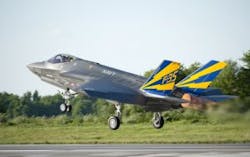Lockheed Martin delivers U.S. Navy’s first F-35C
FORT WORTH, Texas, 26 June 2013. CF-6, the first Lockheed Martin (NYSE:LMT) F-35C Lightning II Navy carrier variant (CV) aircraft and the Navy's first 5th-generation F-35 production aircraft, has arrived at Strike Fighter Squadron 101 at Eglin Air Force Base, Fla.
CF-6 joins a fleet of 12 F-35A conventional takeoff and landing (CTOL) jets and 13 F-35B short takeoff and vertical landing (STOVL) jets already assigned to Eglin. Later this year, four additional CVs will join the fleet. Strike Fighter Squadron 101, which serves as the F-35C Fleet Replacement Squadron, employs the F-35 aircraft to train pilots and maintainers.
U.S. Navy test pilot Lt. Cmdr. Chris Tabert flew CF-6 on its ferry flight. Last year, he became the first military test pilot to fly all variants of the F-35.
"We are committed to the Navy's vision for the F-35 that will revolutionize forward based combat power in current and future threat environments," says Lorraine Martin, Lockheed Martin executive vice president and F-35 program general manager. "The F-35 represents the new standard in weapon systems integration, maintainability, combat radius and payload that brings true multi-mission capability to the Navy."
The F-35C, the U.S. Navy and Marine Corps' CV, has larger wings and more robust landing gear than the other F-35 variants. The CV has the greatest internal fuel, at 19,624 pounds, making it suitable for catapult launches and fly-in arrestments aboard naval aircraft carriers. Its wingtips fold to allow for capacity and, like the F-35B, the C-variant uses probe and drogue refueling.
The F-35 Lightning II is a 5th-generation fighter, combining advanced stealth with fighter speed and agility, fused sensor information, network-enabled operations, and advanced sustainment. Three distinct variants of the F-35 will replace the A-10 and F-16 for the U.S. Air Force, the F/A-18 for the U.S. Navy, the F/A-18 and AV-8B Harrier for the U.S. Marine Corps, and a variety of fighters for at least 10 other countries.
The U.S. Navy plans to declare Initial Operational Capability with the CV in 2019.

